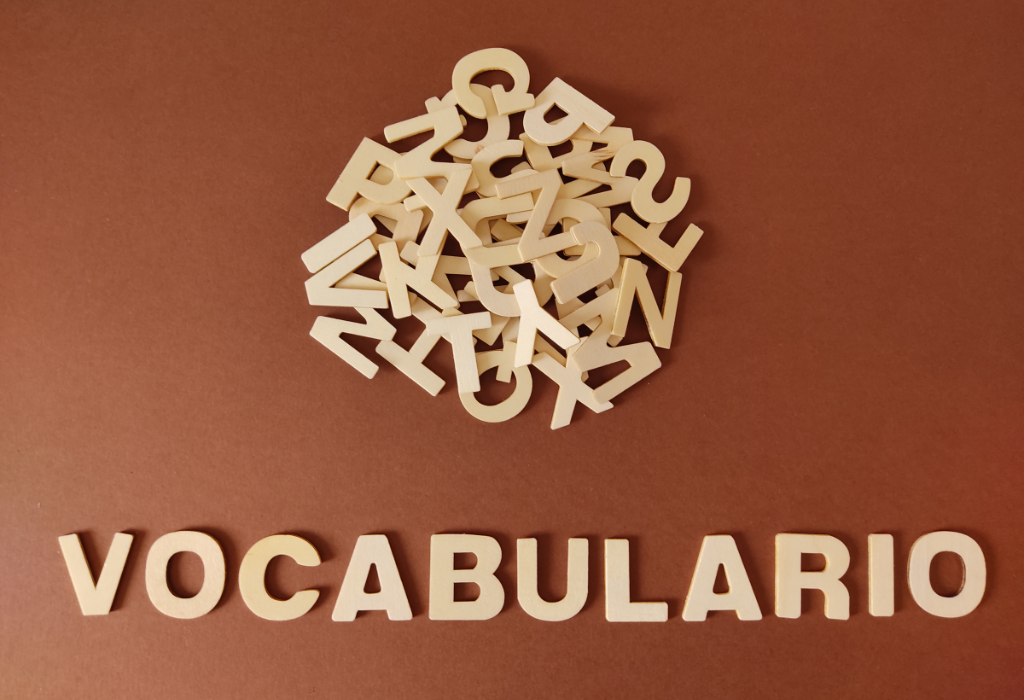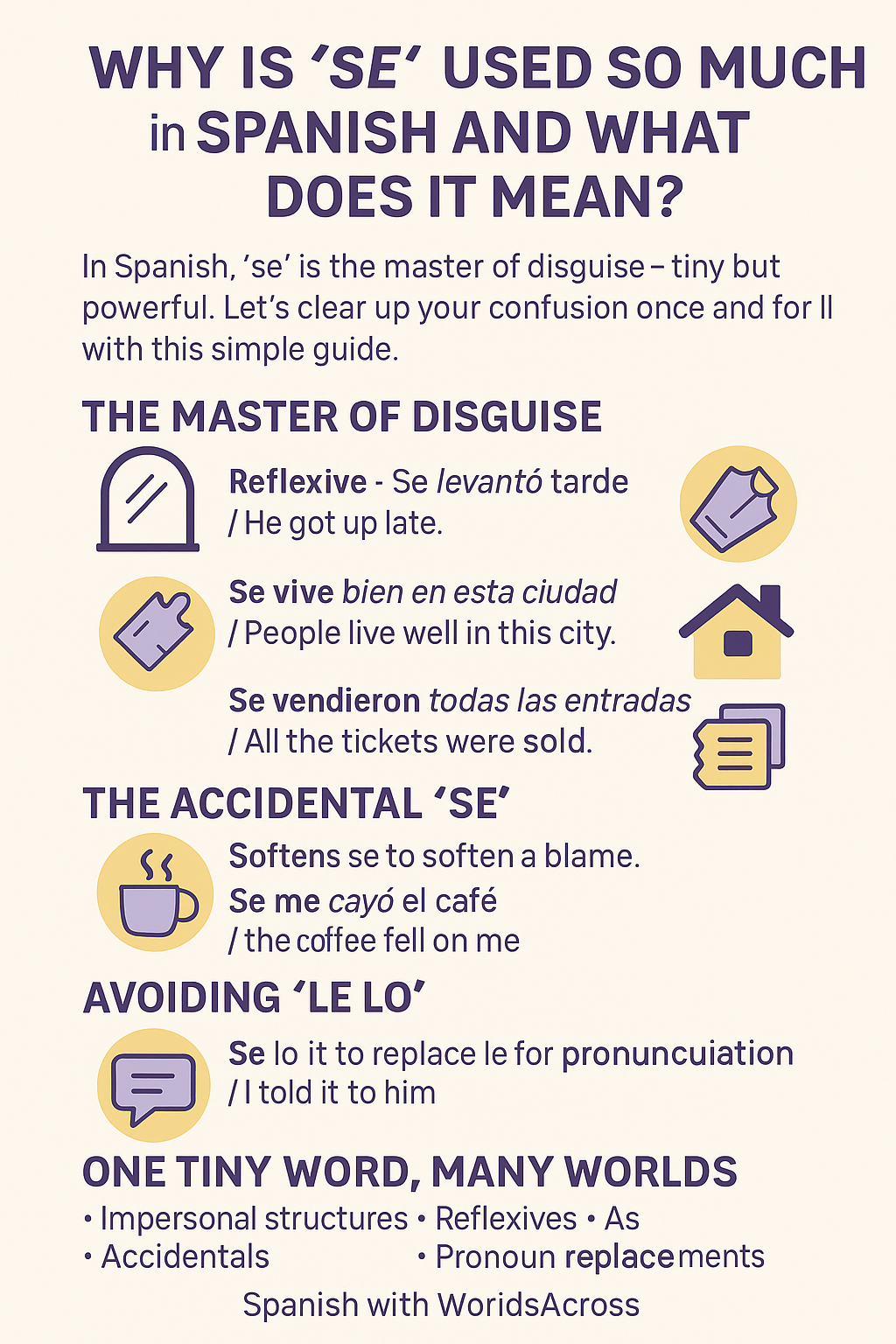Why is “se” used so much in Spanish and what does it mean?
Have you ever noticed “se” popping up everywhere and felt like it’s a grammatical ghost nobody fully explains? You’re not alone. “Se” is like that mysterious character in a movie: it shows up out of nowhere, keeps changing roles, and turns out to be key to the whole plot.
In Spanish, “se” isn’t just one thing. It’s the actor, the narrator, and the director all at once.
And even though it’s tiny, its presence is massive. That’s why today I’m going to show you the true meaning of “se” in Spanish. And I promise—by the time you finish reading, you’ll see it with new eyes.
Let’s clear up your confusion once and for all with this simple guide to the Spanish pronoun “se.”

The master of disguise: how “se” transforms
Let’s start with this:
“Se levantó tarde” / He got up late.
Here, “se” is reflexive: the action reflects back on the subject. It’s like a grammatical mirror.
But wait...
“Se vive bien en esta ciudad” / People live well in this city.
Now “se” isn’t reflexive—it’s impersonal. We don’t know who’s living well, but we know life is good there.
And how about this one?
“Se vendieron todas las entradas” / All the tickets were sold.
Here, “se” is passive. The focus is on the action, not who did it.
Three uses in three seconds!
As you can see, it’s not that Spanish is confusing—it’s just rich with nuance… and “se” is one of the brightest examples.
The art of avoiding blame: the accidental “se”
Picture this: you spill coffee on your friend’s couch. In English, you’d say, “I spilled the coffee.”
But in Spanish…
“Se me cayó el café” / The coffee fell on me.
Aha! We use “se” to soften the blame. It’s as if the coffee had a life of its own and jumped out of your hand.
This usage says a lot about Hispanic culture: politeness, indirectness, empathy.
Knowing these kinds of structures not only improves your grammar—it makes you sound more human.
Yes, the meaning of “se” in Spanish also comes from the heart. And it shows.
Technical trick, elegant result: avoiding “le lo”
Here comes one of those refined language details:
❌ Le lo dije
✅ Se lo dije / I told it to him.
Notice the change? When the pronoun “le” comes before “lo,” “la,” “los,” or “las”… it turns into “se”!
Why? Because Spanish avoids awkward sounds (called cacophony). The language likes to flow—like a good tango—without stumbles.
This tiny stylistic shift shows how much care goes into the sound and beauty of speech.
The Spanish pronoun “se,” when explained like this, becomes almost poetic.
One tiny word, many worlds
The beauty of “se” is that it speaks to many ideas at once. You’ll see it in:
-
Impersonal structures → Se dice que va a llover / They say it’s going to rain.
-
Reflexives → Se baña por la mañana / He showers in the morning.
-
Accidentals → Se me olvidó tu nombre / I forgot your name.
-
Passives → Se construyeron hospitales / Hospitals were built.
-
Pronoun replacements → Se lo entregaron a tiempo / They handed it in on time.
So the meaning of “se” in Spanish opens doors to many scenes—each with its own mood, purpose, and story.
And once you master it, your Spanish becomes more natural, precise, and elegant.

So… what do I do with all this?
First of all: don’t get frustrated if “se” still confuses you. Even native speakers question it sometimes.
But every time you see it, ask yourself:
Why is it here? What is it trying to say?
Start with real phrases like:
-
Se fue sin decir nada / He left without saying anything.
-
Se rompió la ventana / The window broke.
-
Se lo contaron ayer / They told him yesterday.
Listen, repeat, play with it. Language is also learned through intuition.
The more you practice, the more natural “se” will feel.
Remember: the meaning of “se” in Spanish isn’t static—it’s a grammatical dance. And you’re just about to start dancing like a native.
In summary: “se” connects you to the soul of the language
“Se” is much more than a grammar particle. It’s a compass that directs tone, focus, and intent. Mastering it will help you write better, speak more confidently, and understand the subtleties of Spanish in a new way.
Yes, the meaning of “se” in Spanish can seem tricky at first—but every step you take brings you closer.
Like any great story, it starts with curiosity and grows with company. Because even if you study solo, there will always be someone—a native tutor, a passionate coach, or a welcoming community like WorldsAcross—ready to walk this language journey with you.
Spanish is full of beautiful secrets. And “se” is one of them.
Now that the Spanish pronoun “se” has been explained clearly… are you ready to discover the rest?



